Dublindentalcenterpa.com
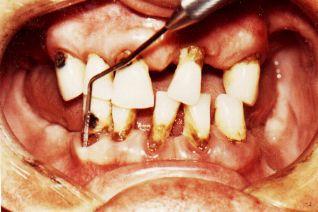
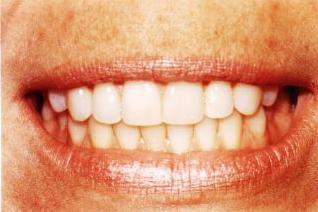

GUM DISEASE?? YOU COULD BE AR RISK!!
GUM DISEASE
Loose Teeth
Bleeding Gums
Bone Loss
Bad Breath & Odor
Tartar Buildup
Plaque &Bacteria
HEALTHY TEETH & GUMS
NO Loose Teeth!!
NO Bleeding Gums!!
NO Bone Loss!!
LESS Bad Breath!!
NO Tartar Buildup!!
NO Plaque & Bacteria!!
REPORT
DR. DEAN L. CIROCCO, DMD
Allentown Dental Center, PC SMILEHEALTHY.COM Dublin Dental Center, PC
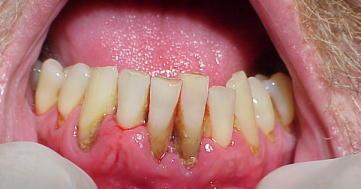
Periodontal Disease
After the age of about 25, the most common reason for the loss of teeth is gum disease,
technically known as periodontal disease, or periodontitis. Periodontal disease is
characterized by swollen, red gums, bleeding gums, receding gums, gum abscesses,
teeth that begin to look longer and longer (prompting the old saying "long of tooth") and
eventually, loose teeth. Affected teeth loosen to the point that they become painful and
useless and either fall out themselves, or must be removed.
Periodontal disease is a bacterially induced, localized,
chronic inflammatory disease which destroys connective
tissue and bone that support the teeth. Periodontitis is
common, and it affects nearly 75% of Americans
Nationwide.
Though the the disease is INDUCED (begins) by bacterial infection, the real damage to the oral tissues is caused by the body's immune response to the infection. Once the infection takes hold, the body becomes primed to fight it, and the immune response begins the destruction of the tissues that support the teeth. Environmental and genetic factors as well as acquired risk factors such as smoking, mental anxiety, depression, obesity, diabetes mellitus and exposure to tobacco accelerate the body's inflammatory processes. Although bacteria initiate periodontitis, host-modifying risk factors appear to influence the severity and extent of disease.
Periodontal disease begins with poor oral hygiene, but it is easily prevented by brushing, and by cleaning between the teeth with floss or thin toothpicks. It is, however, VERY difficult to stop once it starts. It is usually painless, and by the time the first acute abscess starts, some teeth may already be beyond saving. The first sign of periodontal disease is bleeding gums. The last sign of periodontal disease is no teeth.
There are numerous treatment options for the services that help detect and treat gum disease. Our
"Standard Exam" will help determine if gum disease is present, but our "Complete Dental Physical"
exam has an Oral DNA test component that will help determine what bacteria in your
mouth are causing the problem.
Also, treatment ranges can range from full or partial quadrant areas, and whether or not
a laser will be used to assist in your treatment. We have a full compliment of options
that you can choose from based on the data from your personalized exam to deliver
your periodontal care (the most expensive portion of periodontal treatment is the
start-up costs, essentially making up for lost time). Also, there are annual periodontal
maintainence costs.
Allentown Dental Center, PC SMILEHEALTHY.COM Dublin Dental Center, PC
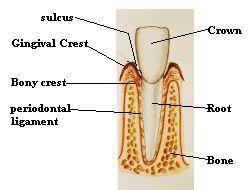
What is Periodontal Disease?
CONGRATULATIONS!! If you are reading this, then you are taking the first step towards
revitalizing your oral health!!
In order to understand gum disease, you must first understand the way the teeth and
supporting structures are built. The part of the tooth you can see in your mouth is called the
crown of the tooth. It is held in the mouth by the root which is embedded in your jaw bone. It is
attached to the bone by way of a thin "stocking" called the periodontal ligament. The bone is, of
course covered by the gums which are called the gingiva. The gingiva attach to the teeth
slightly below the highest level they reach on the tooth.
The topmost part of the gingiva is called the gingival crest,
and the inside of the little pocket between the gingival
crest and the bottom of the pocket is called the gingival
sulcus. All the bony and soft tissue that supports the tooth
is called the periodontium and when this organ becomes
sick, we say the patient has Periodontal disease. As the
gums swell, they detach from the tooth and form a space,
or "pocket," between the tooth and gum. Bacteria can grow
rapidly in the pockets, and that is how it all starts!!
If your hands bled when you washed them, would you be
concerned? Yet, many people think it is normal if their
gums bleed when they brush or floss. Seventy-five to
eighty percent of Americans have some form of
periodontal disease!!
If oral hygiene slips or you skip dental visits, plaque builds up on the teeth. Eventually,
it spreads below the gum line. The bacteria are protected there because your
toothbrush can't reach them!! If plaque is not removed, the bacteria will continue to
multiply, the gums become more inflamed, and can cause a more serious infection.
Allentown Dental Center, PC SMILEHEALTHY.COM Dublin Dental Center, PC
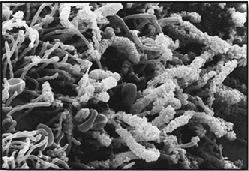

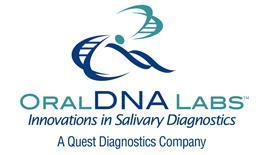
What CAUSES Periodontal Disease?
For many years scientists have been trying to figure out what causes periodontal disease. It is
now well accepted that various types of BACTERIA in dental PLAQUE are the major villains.
Our mouths are full of bacteria. These bacteria, along with mucus and other particles, constantly
form a sticky, colorless "plaque" on teeth. Brushing and flossing help get rid of plaque. In an
effort to get rid of the bacteria, the cells in your immune system release substances that inflame
and damage the gums, periodontal ligament or alveolar bone. THE ONLY WAY TO
ACCURATELY DETECT IF YOU HAVE PATHOGENIC BACTERIA IN YOUR MOUTH IS
WITH AN ORAL DNA PATHOLOGY TEST!
Swollen and bleeding gums are early signs that your gums are
infected with bacteria. If nothing is done, the infection can
spread. It can destroy the structures that support your teeth in
your jawbone. Eventually, your teeth can become so loose that
they have to be removed!!
Allentown Dental Center, PC SMILEHEALTHY.COM Dublin Dental Center, PC
Other CAUSES of Periodontal Disease
Tobacco smoking or chewing - Need another reason to quit smoking? Smoking is one of the
most significant risk factors associated with the development of periodontitis. Smoking
increases the risk of periodontal disease. The longer you smoke, and the more you smoke, the
higher the risk. If you have periodontal disease, smoking makes it more severe. Smoking is the
main cause of periodontal disease that is resistant to treatment and smoking can lower the
chances of success of some treatments. Smokers tend to collect more tartar on their teeth. They
often develop deeper periodontal pockets once they have gum disease. They also are likely to
lose more bone as the disease gets worse. Unlike many other factors that affect the health of
your gums, smoking is under your control!! Quitting smoking can play a major role in bringing
periodontal disease under control.
Tartar Buildup - Another reason to remove plaque promptly is that
over time it becomes hardened or calcified and turns into calculus.
This is commonly called TARTAR. Even more plaque attaches to
calculus because it's a rougher surface than tooth enamel. It's also
rougher than cementum, a layer that covers the tooth root. Broken
teeth and fillings may also cause increased calculus buildup due to
the irregular surfaces. Layers of calculus and plaque build up, in a
downward spiral.
or Clenching of Teeth — These habits won't cause periodontal disease. However,
they can lead to more severe disease if your gums are already inflamed. These habits exert
excess force on the teeth. This pressure speeds up the breakdown of the periodontal ligament
and bone, causing GUM RECESSION!! This may cause exposed tooth roots and lead to
SENSITIVE TEETH!! Your dentist can create a custom guard appliance to help reduce the
pressure of clenching or grinding on the teeth.
Stress - Research shows that stress can make it more difficult for our bodies to fight infection,
including periodontal disease.
Medications - Some drugs, such as antidepressants and some heart medicines, can affect oral
health because they lessen the flow of saliva. (Saliva has a protective effect on teeth and gums.)
Pregnancy or use of oral contraceptives - These changes can make gums more sensitive and
make it easier for gingivitis to develop.
Illnesses- Diseases like cancer or AIDS and their treatments can also affect the health of gums.
Genetic susceptibility- Some people are more prone to severe periodontal disease than others
Allentown Dental Center, PC SMILEHEALTHY.COM Dublin Dental Center, PC
Are there related HEALTH CONCERNS to Gum Disease? YES!!
DIABETES - People with diabetes are at higher risk for developing infections, including
periodontal disease. People with diabetes are more likely to have periodontal disease than
people without diabetes, probably because diabetics are more susceptible to contracting
infections. In fact, periodontal disease is often considered the sixth complication of diabetes.
Those people who don't have their diabetes under control are especially at risk.
One study has found that "poorly controlled type 2 diabetic patients are more likely to
develop periodontal disease than a well-controlled type 1 diabetic."
Research suggests that the relationship between periodontal disease and diabetes goes both ways - periodontal disease may make it more difficult for people who have diabetes to control their blood sugar. Severe periodontal disease can increase blood sugar, contributing to increased periods of time when the body functions with a high blood sugar. This puts diabetics at increased risk for diabetic complications. Thus, diabetics who have periodontal disease should be treated to eliminate the periodontal infection.
HEART DISEASE – Gum disease may increase the risk of clogged arteries and heart disease,
and is believed to worsen existing heart disease. Several theories exist to explain the link
between periodontal disease and heart disease. One theory is that oral bacteria can affect the
heart when they enter the blood stream, attaching to fatty plaques in the coronary arteries (heart
blood vessels) and contributing to clot formation. Coronary artery disease is characterized by a
thickening of the walls of the coronary arteries due to the buildup of fatty proteins. Blood clots
can obstruct normal blood flow, restricting the amount of nutrients and oxygen required for the
heart to function properly. This may lead to heart attacks.
Researchers have found that people with periodontal disease are nearly twice as likely
to suffer from coronary artery disease as those without periodontal disease.
STROKE - Gum disease may increase the risk of the type of stroke that is caused by
blocked arteries. One possibility is that the inflammation caused by periodontal disease
increases plaque build up, which may contribute to swelling of the arteries.
Additional studies have pointed to a relationship between periodontal disease and
stroke. Some studies have looked at the causal relationship of oral infection as a risk
factor for stroke in people diagnosed with acute cerebrovascular ischemia.
PREGNANCY FACTORS — A woman who has gum disease during pregnancy may
be more likely to deliver her baby too early or be "PRE-TERM". The infant may also be
more likely to be of LOW BIRTH WEIGHT.
One study showed that up to 18% of premature, low-birth-weight babies might be
linked to the mother's gum disease.
Allentown Dental Center, PC SMILEHEALTHY.COM Dublin Dental Center, PC
RESPIRATORY INFECTIONS — Gum disease may cause lung infections and worsen
existing lung conditions when bacteria from the mouth reach the lungs. Such lung
infections could lead to pneumonia, and studies are being done now to help determine
this association .
SEVERE OSTEOPENIA – Reduction in bone mass (OSTEOPENIA) is associated with gum
disease and related tooth loss. The severity has been connected to tooth loss in
postmenopausal women.
COMMON SIGNS OF PERIODONTAL DISEASE
Gums that bleed easily Red, swollen, tender gums Gums that have pulled away from the teeth Persistent bad breath or bad taste Permanent teeth that are loose or separating Any change in the way your teeth fit together when you bite Any change in the fit of partial dentures
Is it possible to have periodontal disease and have no
warning signs?
YES!! That is one reason why regular dental checkups and
periodontal examinations are very important. Treatment
methods depend upon the type of disease and how far the
condition has progressed. Good oral hygiene at home is
essential to help keep periodontal disease from becoming
more serious or recurring. You don't have to lose teeth to
periodontal disease!! Brush, clean between your teeth, eat a
balanced diet, and schedule regular dental visits for a
lifetime of healthy smile.
Allentown Dental Center, PC SMILEHEALTHY.COM Dublin Dental Center, PC
DIAGNOSIS of Periodontal Disease
Several procedures can be used to help determine a diagnosis of periodontal disease.
Medical History. The dentist and hygienist will first take a medical history to reveal any past or present periodontal problems, any underlying diseases that might be contributing to the problem, and any medications the patient is taking. After noting the general state of oral hygiene, the dentist may ask about the quality of home dental care.
Genetic Testing. THE ONLY WAY TO ACCURATELY DETECT IF
YOU HAVE PATHOGENIC BACTERIA IN YOUR MOUTH IS WITH
AN ORAL DNA PATHOLOGY TEST! This test will help
identify the type and concentration of perio-pathogenic bacteria, and
even determine a patient's genetic predisposition for periodontal disease.
This is a simple and easy test of your saliva , and better yet provides a
better risk assessment with more predictable outcomes of treatment.
Periodontal Probing. This is a procedure used to measure and determine the severity of
periodontal disease:
The hygienist uses a mirror and a periodontal probe, a fine instrument calibrated in
millimeters (mm), which is used to measure pocket depth.
The probe is held along the length of the tooth with the tip placed in the pocket. The
tip of the probe will then touch the point where the connective tissue attaches to the tooth.
The hygienist will "walk" the probe to six specified points on each tooth, three on the
buccal (cheek) and three on the lingual (tongue) sides. The hygienist measures the depth of the
probe at each point.
Pocket depths greater than 3 mm usually indicate disease!!
Physical Examination. Inspection of the Gum Area. The dentist and hygienist inspect the color and shape of gingival tissue on the cheek (buccal) side and the tongue (lingual) side of every tooth and compares these qualities to the healthy ideal. Redness, puffiness, and bleeding upon probing indicate inflammation. These measurements help determine the condition of the connective tissue and amount of gingival overgrowth or recession.
X-rays. X-rays are taken to show any loss of bone structure
supporting the teeth, and are necessary for diagnosis of periodontal
disease. They show calculus deposits and bone loss below the
gumline.
Testing Tooth Movement. Tooth mobility is determined by pushing
each tooth between two instrument handles and observing any movement.
Allentown Dental Center, PC SMILEHEALTHY.COM Dublin Dental Center, PC
TREATMENTS of Periodontal Disease
These following factors are important to understand in the treatment of periodontitis. The goal is to
control the current active infection and then closely monitor for signs of disease activity on a regular
basis. Once susceptible to this disease it must be monitored for the rest of the patient's life. The ultimate
goal is to prevent further bone loss and keep the teeth involved for as long as possible.
Chronic- Periodontitis is typically a slow moving condition, taking many months or even years to
develop. Once the disease develops and is diagnosed, it is never really cured. Instead it is managed, much
like other chronic conditions like high blood pressure or diabetes.
Insidious- Periodontitis is usually silent until its later stages. Patients typically have no symptoms until
the disease has progressed very far. It must be diagnosed through a thorough periodontal exam.
Symptoms which do occur late in the disease are bleeding gums, sore or itchy gums, loose teeth, change
in bite, bad breath, and acute gum abscesses.
Episodic- The actual disease activity of infection causing bone loss does not occur at all times in all places
in the mouth. Instead, the active stages occur in an on/off fashion at various locations in the mouth. This
can only be determined by accurate exams initially and at recall.
Treatment regimens are determined on an individualized basis.
Most traditional treatments follow the same basic pattern.
Non-Surgical Treatments
First the infection is disrupted by thorough cleaning below the gumline by the hygienist
through a process called "scaling. " This is a careful cleaning of the root surfaces to
remove plaque, calculus, and bacterial toxins from deep periodontal pockets. The
procedure is usually done in sections (quadrants) at a time, and may take one to four or
more appointments. Local anesthesia is sometimes used for patient comfort, but is
usually not necessary. The goal is to remove the tartar and bacteria from the root
surfaces to allow healing and reattachment of the gums.
After scaling, many patients do not require any further active treatment, including
surgical therapy provided pocket depths and bleeding points are reduced. However,
the majority of patients will require on going maintenance therapy to sustain health
for the rest of their life!! Non-surgical therapy does have its limitations, however, and
when it does not achieve periodontal health, surgery may be indicated to restore
periodontal anatomy damaged by periodontal diseases and to facilitate oral hygiene
practices.
The gums are given time to heal once scaling is done (6 weeks) and the mouth is re-
examined to evaluate the success of the treatment and determine the need for further
care.
Allentown Dental Center, PC SMILEHEALTHY.COM Dublin Dental Center, PC
Antibiotics / Medicaments
Patients are often given oral or systemic anibiotics (i.e., Amoxicillin or Periostat
Doxycycline) and mouth rinse (i.e., Perioguard with Chlorhexidine) to aid in the
reduction of periodontal pockets.
THE ONLY WAY TO ACCURATELY DETECT WHICH PATHOGENIC
BACTERIA YOU HAVE IN YOUR MOUTH IS WITH AN ORAL DNA
PATHOLOGY TEST! That way we can prescribe antibiotics more accurately,
and not waste time fighting the wrong bacteria.
In some individuals that need only selective sites done, medicaments
such as Arestin can be placed. Arestin is a time release antibiotic,
which also dispenses the medicine over a 30 day cycle. The idea of the
time release is to deliver a constant agent against bacteria in an
individual pocket to help reduce inflammation and pocket depth.
Traditional Periodontal Surgery
During this procedure, the gum tissue is folded back in an effort to remove the disease-causing plaque, bacteria, and calculus before securing the tissue into place. In some cases, irregular surfaces of the damaged bone are smoothed to limit areas where disease-causing bacteria can hide. This allows the gum tissue to better reattach to healthy bone.
Your dentist may recommend a regenerative procedure when the bone supporting your teeth has been destroyed. These procedures can reverse some of the damage by regenerating lost bone and tissue.
During this procedure, the gum tissue is folded back and disease-causing bacteria is removed. Membranes, bone grafts , or tissue-stimulating proteins can be used to encourage your body's natural ability to regenerate bone and tissue.
There are many options to enhance support for your teeth and to restore your bone to a healthy level.
Allentown Dental Center, PC SMILEHEALTHY.COM Dublin Dental Center, PC
LASER PERIODONTAL THERAPY
One of the more exciting applications of dental lasers is in their application in periodontal disease. For years now dentists on the leading edge of periodontal care have been devising ways to incorporate these excellent tools into their patient's care. Our office has been using lasers as an adjunct to our periodontal program since 2007. The recent addition of the Odyssey Laser has added an exciting new dimension to our periodontal care. Lasers are characterized by their wavelength; each type of laser having certain clinical advantages and disadvantages. Laser periodontal protocols take
advantage of each machines characteristics, and uses wavelengths popular in treating gum disease, allowing us to take advantage of all the abilities of each device without the limitations of a single wavelength. We combine this with modern technology with genetic (DNA) testing that results in a thorough & effective protocol.
Laser surgery for periodontal disease in fewer appointments
Personalized antimicrobial therapy
No scalpels & Sutures
Greatly reduced post operative pain
More rapid healing
Less invasive procedures
Laser disinfection of diseased periodontal pockets
Laser and piezoelectric assisted tartar removal (no more scraping!)
Less expensive than traditional surgery
What are the benefits of these procedures?
Reducing pocket depth and eliminating existing bacteria are important to prevent damage caused by the progression of periodontal disease and to help you maintain a healthy smile. Eliminating bacteria alone may not be sufficient to prevent disease recurrence. Deeper pockets are more difficult for you and your dental care professional to clean, so it's important for you to reduce them. Reduced pockets and a combination of daily oral hygiene and professional maintenance care increase your chances of keeping your natural teeth – and decrease the chance of serious health problems associated with periodontal disease.
Allentown Dental Center, PC SMILEHEALTHY.COM Dublin Dental Center, PC
GUM GRAFTING (Treat Recession)
Periodontal procedures are available to stop further dental problems and gum recession, and/or to improve the esthetics of your gum line.
"Exposed tooth roots are the result of GUM RECESSION. Perhaps you wish to
enhance your smile by covering one or more of these roots that make your teeth
appear too long. Or, maybe you're not bothered by the appearance of these areas, but
you cringe because the exposed roots are sensitive to hot or cold foods and liquids."
Your gums may have receded for a variety of reasons: brushing too hard, problems with your bite, and / or your tissue biotype. You may not be in control of what caused the recession, but prior to treatment your dentist can help you identify the factors contributing to the problem. Once these contributing factors are controlled, a soft tissue graft procedure will repair the defect and help to prevent additional recession and bone loss.
Soft tissue grafts can be used to cover roots or develop gum tissue due to excessive gingival recession. During this procedure, the dentist takes gum tissue from your palate or another donor source to cover the exposed root. This can be done for one tooth or several teeth to even your gum line and reduce sensitivity.
What are the benefits of this procedure?
Eliminating existing bacteria and regenerating bone and tissue helps to reduce pocket depth and repair damage caused by the progression of periodontal disease. With a combination of daily oral hygiene and professional maintenance care, you'll increase the chances of keeping your natural teeth, and decrease the chances of serious health problems associated with periodontal disease. Periodontal procedures are available to lay the groundwork for restorative and cosmetic dentistry and to improve the esthetics of your gum line.
Allentown Dental Center, PC SMILEHEALTHY.COM Dublin Dental Center, PC
DENTAL IMPLANTS… An alternative to Treating Periodontal Disease
One of the most important concepts of periodontal
disease as it relates to teeth, is if the teeth are loose or
not. Periodontal disease ultimately eats away at your
jawbone, causing your teeth to get loose. Upon an
individual assessment it may be more beneficial to
consider alternatives to preserving natural teeth and
treating the gums. Unfortunately, this would lead to
tooth removal and ultimately dentures!!
In today's era of dentistry, permanent teeth are an option even if you've had all of your teeth removed. This is the evolution of dental implants, which can be called your third set of teeth!!! Dental implants can be used to replace single, multiple, or even a whole arch or mouth of teeth. Depending on your wants and needs, this may be the best option for replacing any tooth.
How long do I need MAINTENANCE? FOR LIFE!
The answer varies from person to person. Your dentist will recommend a schedule that best that is tailored to protect your periodontal health. The intervals between visits may range from every few weeks to four times per year, in addition to checkups by your general dentist. You can prevent periodontal disease by practicing good oral hygiene and visiting your dentist regularly. Daily brushing and flossing, when done correctly, can help to remove most of the plaque from your teeth. Most people should see the dentist about once every six months.
If you already have gum disease you should visit more often!!
… An individualized home care regimen is devised for the patient to control plaque. Regular recall visits are crucial for managing this disease over the long term. Frequent recalls allow regular, early removal of tartar accumulations, disruption of bacteria in deeper pockets, and close monitoring of disease activity throughout the mouth. Any further treatment needs can be addressed as soon as possible. Controlling plaque levels through proper home care is critical to the success of the treatment.
Allentown Dental Center, PC SMILEHEALTHY.COM Dublin Dental Center, PC
THANK YOU for choosing us to
inform you about your dental care
needs. We hope this report helps in
making a better informed decision
about how dental care in our office
will be provided to you. Please feel
free to contact our office via phone,
website, or e-mail us any further
questions you may have.
You Deserve to Smile Healthy Again!!
Dr. Dean L. Cirocco AND TEAM
Allentown Dental Center, PC SMILEHEALTHY.COM Dublin Dental Center, PC
Source: http://www.dublindentalcenterpa.com/wp-content/uploads/periodontal_report_sheet.pdf
Dermatologic surgery Strategies for prevention of scars: what can we learn fromfetal skin? Mohammad Reza Namazi1, MD, Mohammad Kazem Fallahzadeh2, MD, andRobert A. Schwartz3, MD, MPH 1Stem Cell and Transgenic Technology Research Center, Shiraz University of Fetal wound healing occurs rapidly and without scar formation early in gestation. Medical Sciences, Shiraz, Iran,
MANAGEMENT OF OBSTETRIC HAEMORRHAGE Original article by: Dr Adrian Jennings, Dr James Brunning, Dr Catherine Brennan, Russells Hall Hospital, Dudley, UK Major obstetric haemorrhage is a common cause of maternal morbidity and mortality. In the UK, major haemorrhage occurs in approximately 3.7 per 1000 births. Maternal haemorrhage has fallen to being the sixth leading cause of direct maternal death in the 2006-2008 UK ‘Saving Mothers' Lives' national enquiry (mortality rate of 0.39 per 100 000 maternities). It is thought that improvement in the multidisciplinary management of these patients may have contributed to this decline. However, the overall rate in some developed countries appears to be increasing and in less developed countries obstetric haemorrhage remains one of the leading causes of maternal death. World Health Organisation statistics show it complicates up to 10.5% of births, and up to 50% of maternal deaths are attributable to its effects.








